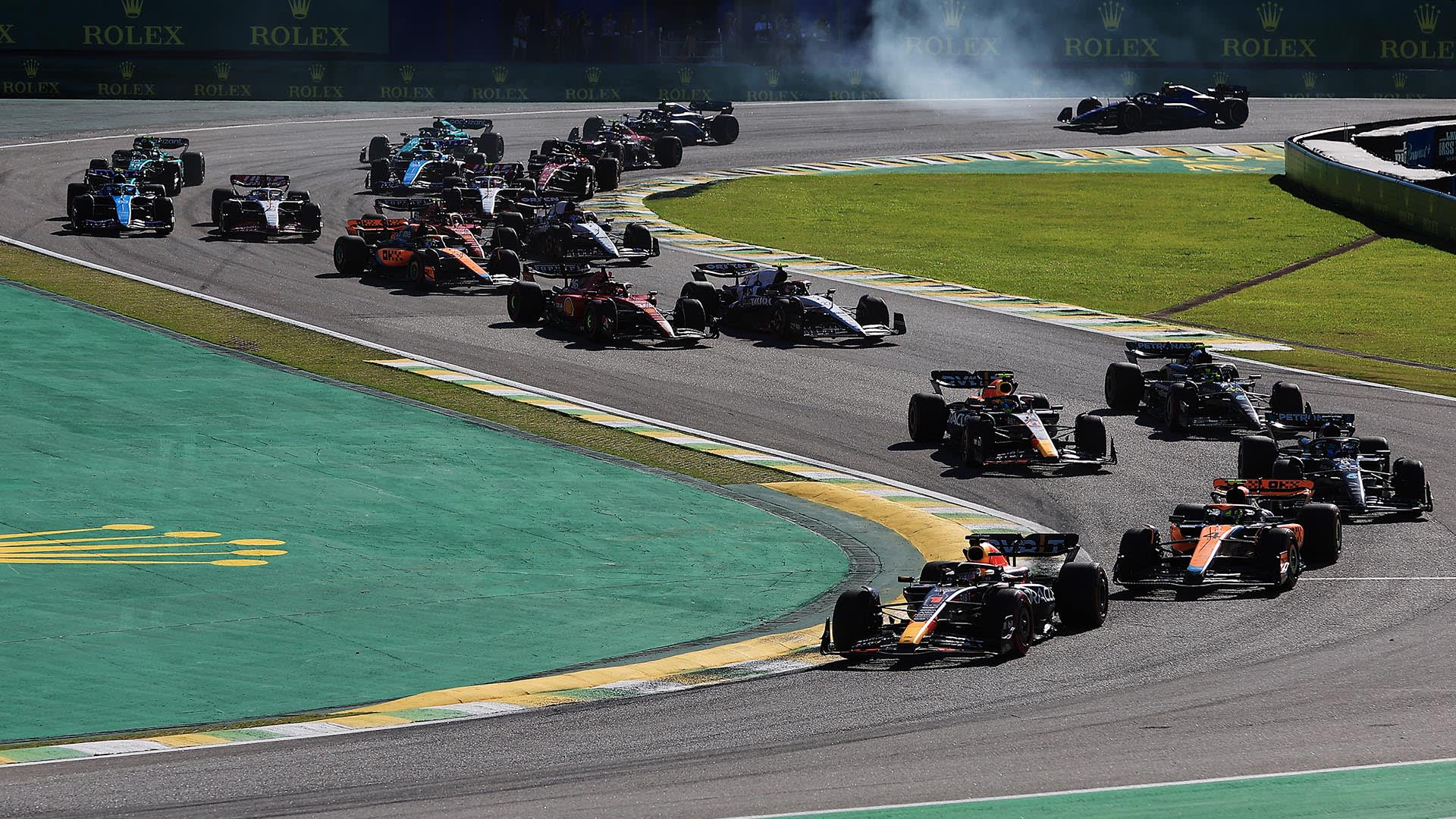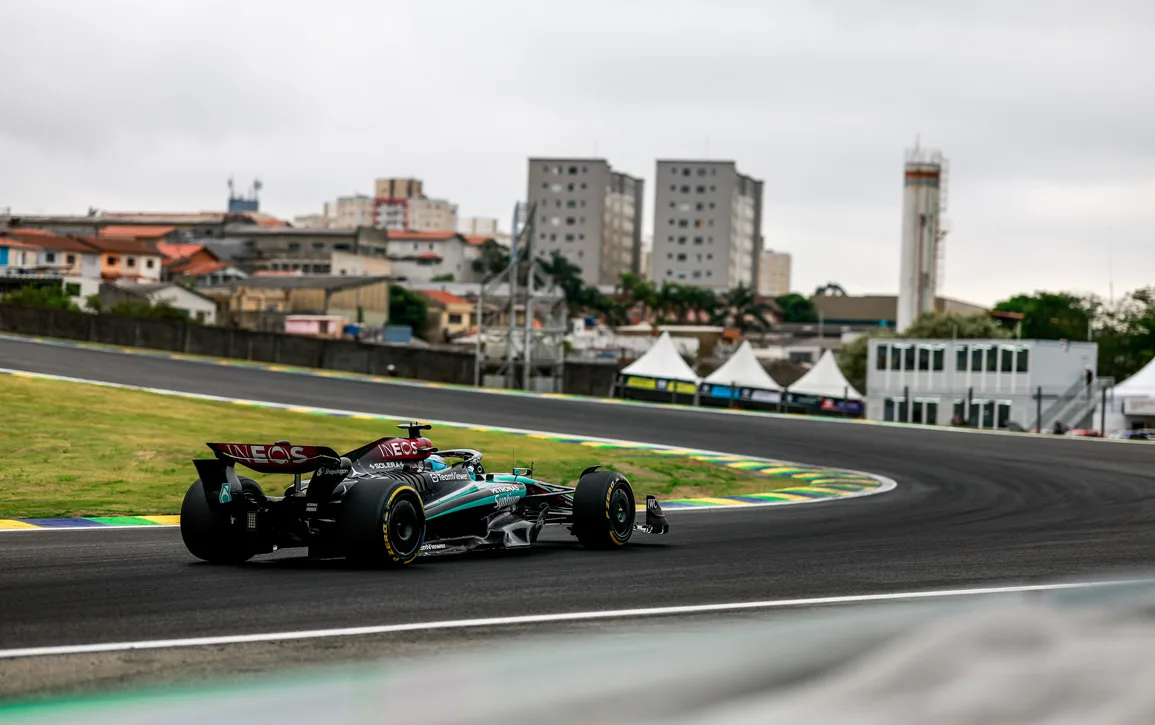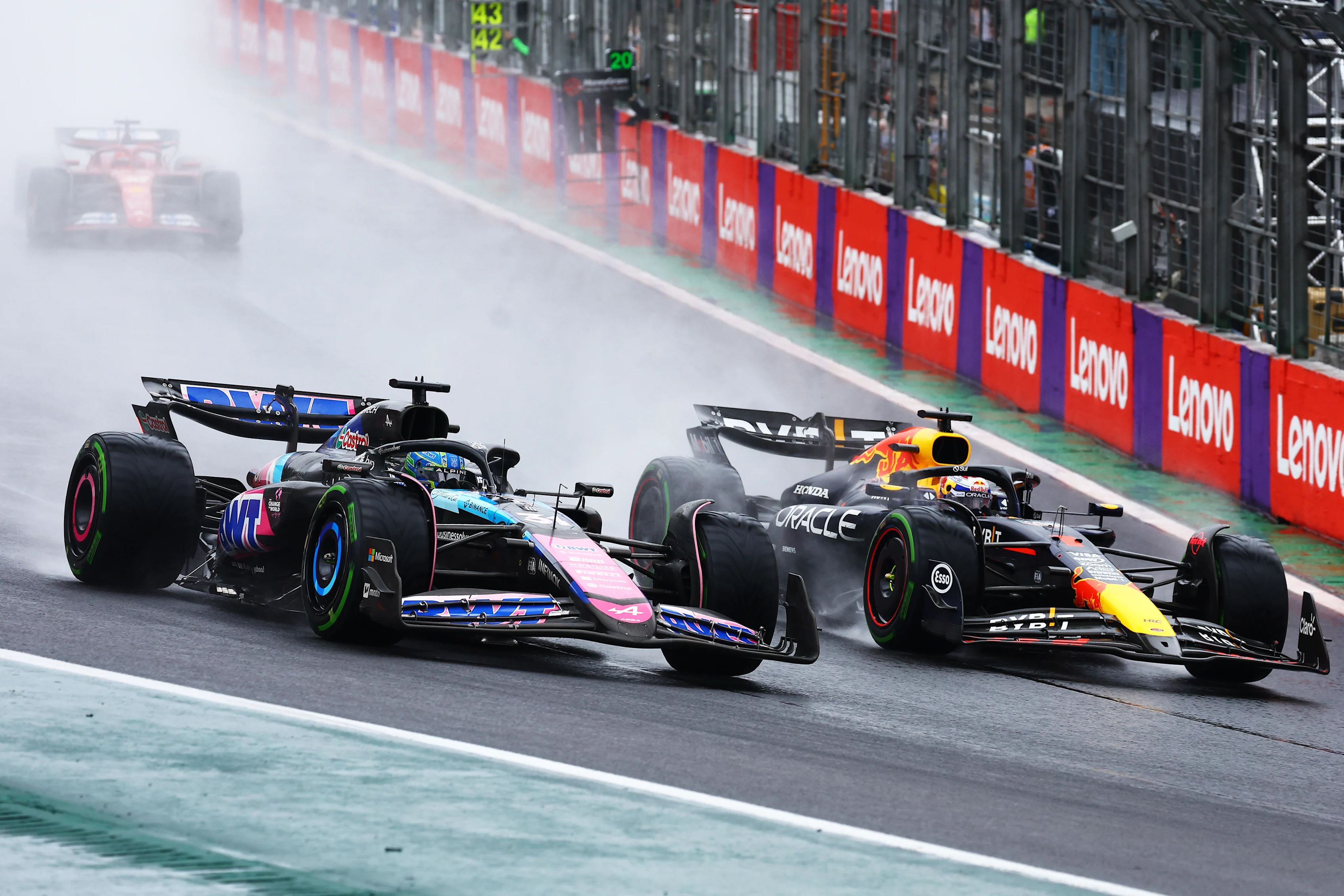
2025 São Paulo Grand Prix: all you need to know
Formula 1 is set for a blockbuster weekend as the paddock descends on the legendary Interlagos circuit for the FORMULA 1 MSC CRUISES GRANDE PRÊMIO DE SÃO PAULO 2025. Taking place from November 7-9, this event is not just another date on the calendar; it is Round 21 of the championship and, crucially, the second last Sprint weekend of the 2025 season.
This sets the stage for a "gripping 2025 F1 title battle" to be contested under the most intense pressure imaginable. A "three-horse race" for the Drivers' Championship has arrived at one of the sport's most unforgiving circuits, but the true X-factor is a dire weather forecast. Long-range models predict a "soggy picture," with a high probability of "biblical downpours" and "persistent wet conditions" for both Sprint Saturday and the Grand Prix on Sunday.

The combination of a high-pressure Sprint format and a deluge of rain creates an exponential likelihood of a championship-altering upset. The Sprint schedule provides only one 60-minute practice session (FP1) on Friday for teams to gather all their setup data. With a 58% chance of showers on Friday, teams will likely get zero dry-running data before their cars are locked into Parc Fermé. They will be forced to gamble on a setup---ride height, wing levels, and cooling---for an entire weekend of wet-weather racing based on a single, compromised hour of practice. This high-stakes lottery neutralizes the engineered advantage of the leading cars and opens the door for chaos.
The 2025 title fight: a three-way battle reaches boiling point
The 2025 season has delivered an all-time classic championship fight. After 20 rounds, the battle for the Drivers' title is on a knife edge. McLaren's Lando Norris leads the standings with 357 points, but his teammate Oscar Piastri sits just one point behind him on 356.

Lurking just behind them is Red Bull's Max Verstappen. The reigning champion is 36 points adrift on 321 points, a gap that is considered "bridgeable" with 116 points still available across the final four rounds.
In the Constructors' Championship, the story is one of total domination. McLaren officially wrapped up the title in Singapore, a testament to their car's season-long performance. The Woking team sits on a remarkable 713 points, built on the balanced, two-driver-scoring brilliance of Norris and Piastri.
McLaren's success serves to highlight Red Bull's structural collapse. While Verstappen has 321 points, his team languishes in fourth place in the standings with 346 points. This reveals that their second driver, Yuki Tsunoda, has contributed only 25 points all season. The 2025 season is a case study in team dynamics: McLaren won the constructors' war with two "A-list" drivers, while Red Bull's failed #2 driver strategy has left Verstappen to fight the drivers' battle entirely alone.
The real Constructors' fight is the lucrative, high-stakes battle for second place, where Ferrari (356 points), Mercedes (355 points), and Red Bull (346 points) are separated by a mere 10 points.
Amidst this title drama is the significant subplot of Lewis Hamilton's "difficult" first year at Ferrari. The seven-time champion is still searching for his "maiden Ferrari grand prix podium," which has been described as the "missing piece" of his 2025 campaign.

Hamilton has taken time "adapting to the team's culture" and, more technically, the car's specific characteristics, such as the Brembo brakes, which Mercedes did not use. "Trusting the front of his car has been a real challenge" all season. His only major success has been a "surprise Sprint pole and win in Shanghai," and while his gap to teammate Charles Leclerc has "reduced considerably," it is the Monegasque driver who has been "claiming all of Ferrari's podiums".
For a driver of Hamilton's stature, this is not just a winless streak; it is a narrative of decline. Interlagos---the site of his legendary 2021 comeback---is one of his last four chances to change that narrative. Arriving at this track adds immense psychological pressure, as he races not just the grid, but the ghost of his 2021 self. The predicted rain may be the very chaos he needs, or it could amplify his difficulty in trusting the front end of his new car.
Key corners: a technical lap of Interlagos
The Autódromo José Carlos Pace is a 4.309 km (2.677 miles) ribbon of asphalt that presents a unique physical and engineering test. Its 15 turns run in a counter-clockwise direction, a rarity that places immense and unusual strain on the drivers' necks. The track is also famous for its "bumpy surface," a characteristic that demands a setup with precise "balance and mechanical grip".

Adding to the complexity is the altitude. At 800m above sea level, Interlagos is the second-highest circuit on the calendar. This thin air creates a complex engineering paradox. The air is less dense, meaning aerodynamic surfaces (wings and floors) are less effective. To compensate, teams are forced to run their maximum-downforce wing packages, similar to those used at Monaco, just to generate a medium-downforce level of grip.
Simultaneously, the power unit's turbocharger must spin significantly faster to compress the thin air and force enough oxygen into the engine, which generates excess heat and mechanical strain. This creates the paradox: the cars are running high-drag wings, but the cooling systems (radiators, brake ducts) are also less effective in the thin air, precisely when the PU is producing more heat. This makes the setup gamble for the Sprint weekend, based on a single wet practice session, a nightmare. Guessing the cooling requirements incorrectly will almost certainly lead to a DNF from an overheating PU or brake failure.
Sector 1 (T1-T3): the 'Senna S'
The lap begins with a high-speed, downhill plunge into the 'Senna S' (Turns 1 and 2). This is a "complex of fast downhill corners requiring precision and bravery". Drivers brake hard on entry and then flick the car left-then-right, managing the rapid change in elevation. This complex is immediately followed by the long, sweeping right-hander, 'Curva do Sol' (Turn 3).

Sector 2 (T4-T11): the twisting infield
After Turn 3, drivers enter a "snaking in-field section". This part of the lap is defined by "high-speed turns and elevation changes". Key corners include the 'Descida do Lago' (Turns 4/5), the fast 'Ferradura' (Turns 6/7), and the 'Pinheirinho' (Turn 9). This sector is where the high-downforce setups are crucial, as it tests the car's "balance and mechanical grip" to its limit.
Sector 3 (T12-T15): the power run
The final sector is "all about power". It is dominated by the slow-speed, left-hand 'Junção' corner (Turn 12). A driver's exit from T12 is arguably the most important part of the entire lap. Getting good traction here is critical, as it sets the speed for the 1.2-kilometer, full-throttle, uphill "Subida dos Boxes" (Ascent of the Pits) that leads through the banked final corners and back to the start-finish line.

Overtaking opportunities: where the race will be won and lost
Interlagos is "very much of a driver's track", and its layout is a masterclass in promoting wheel-to-wheel action. With a historical average of 62 overtakes per race, it is a circuit that guarantees battles.
Overtaking zone 1: Turn 1 (Senna S)
The "most popular place to overtake" on the circuit. After a good exit from 'Junção' (T12), a chasing car benefits from both slipstream and the first DRS zone on the long, uphill main straight. This leads into a "heavy braking zone" for Turn 1, which famously invites "late dives" from brave drivers.
Overtaking zone 2: Turn 4 (Descida do Lago)
The track's design is what makes the racing so spectacular, as it is built for "attack and defense." After the driver who was just passed navigates the 'Senna S' (T1/T2) and 'Curva do Sol' (T3), they immediately get the second DRS zone on the 'Reta Oposta' (Opposite Straight). This leads into another heavy braking zone at Turn 4, 'Descida do Lago'. This is the second-best spot on the track and sees a "massive amount of moves".

This "attack-and-defense" layout actively prevents the boring "DRS trains" seen at other circuits. Because the detection point for the second DRS zone is located after Turn 2, the driver who was just overtaken into Turn 1 (Car B) is now perfectly positioned to get DRS on the next straight and launch an immediate counter-attack. This creates a "right of reply" that promotes the multi-lap duels---like the legendary 2023 battle between Fernando Alonso and Sergio Perez---that make Interlagos an icon of racing.
Tyre selection and strategy: a two-stop race on a new surface
This year's race presents a "difficult puzzle" for team strategists. Pirelli has selected the C2 (Hard), C3 (Medium), and C4 (Soft) compounds for the weekend.
This is a "completely harder step" in compound selection compared to 2024. The decision was made because the C5 (softest) tyre was deemed "not a viable race tyre" last year, prompting a reversion to the more durable 2023 selection.

Normally, a two-stop strategy is "usually... the fastest strategy," favoring the soft (C4) and medium (C3) compounds. However, three factors are combining to make all strategic predictions a total unknown.
-
New Surface: The biggest unknown is that the entire 4.309km track and pit lane have been "completely resurfaced". This new asphalt was cleaned with a "high pressure water washing system" that "increased the abrasiveness of the surface," which will accelerate tyre wear.
-
Surface Temperature: The new asphalt has a "dark colour," which will absorb more heat from the sun. This leads to higher track temperatures, which "always makes things a bit harder on tyres".
-
Track Layout: The "long-radius medium- and high-speed corners" of Sector 2 put a high amount of sustained energy and stress (both "longitudinal and lateral") into the tyres, increasing degradation.
These factors mean that teams are effectively "flying blind." All their historical degradation models are obsolete due to the new, high-abrasion surface. The Sprint format gives them only one 60-minute practice session to build an entirely new tyre model from scratch. Worse, the rain forecast for Friday means they will likely get zero data on slick tyre degradation.
Therefore, teams will go into the Sprint and Grand Prix having to guess how long the C2, C3, and C4 tyres will last. This could lead to massive strategic blunders, "cliff" degradation where tyres suddenly fail, or teams being forced into unplanned three-stop races.
Weather outlook and its impact: a "great equalizer" looms
The weather is the single biggest story of the weekend. The forecast for "persistent wet conditions" is not just a complication; it is a "great equalizer" that could single-handedly decide the championship.

The Forecast:
-
Friday (FP1 / Sprint Qualifying): 58% chance of showers.
-
Saturday (Sprint): 60% chance of "steady rain".
-
Sunday (Grand Prix): "Persistent wet conditions lingering".
Interlagos is notorious for its "microclimate" and "unstable weather," where "sudden thunderstorms" can "hit without warning".
This chaotic forecast is a massive advantage for the championship chaser, Max Verstappen, who is a "master" of the wet. His 2016 drive at Interlagos, where he carved from 16th to 3rd in a "monsoon," is legendary. With a 40% win rate in wet races, this is exactly the chaotic scenario he needs to "reignite his title bid".
For the leaders at McLaren, the rain makes them vulnerable. While Lando Norris "thrives on precision" in the damp, Oscar Piastri's "wet composure is still evolving". Piastri notably struggled with visibility in the 2024 Brazil race, a "crack" that could be exploited.
Ultimately, a wet race turns the event into a "strategic battleground". It negates the dry-running performance of the faster car and becomes a raw test of "skill, strategy, and nerve". High-stakes gambles on Intermediate vs. Full Wet tyres and the timing of the inevitable Safety Car will become the deciding factors. The 2025 championship will likely be determined not by aerodynamics, but by meteorology and driver psychology.
Historical records and statistics
This weekend's battle is set against one of the richest backdrops in F1 history. Interlagos is not just a track; it is a cauldron where legends are forged and championships are decided in the most dramatic fashion possible. The 2025 contenders are aware that this is the track where 1-point swings and rain-induced miracles happen, adding a palpable pressure that exists nowhere else.
Interlagos by the numbers
| Statistic | Value |
|---|---|
| First Grand Prix | 1973 |
| Circuit Length | 4.309 km |
| Race Laps | 71 |
| Race Lap Record | 1:10.540 (Valtteri Bottas, 2018) |
| Most Driver Wins | Alain Prost (6) |
| Most Constructor Wins | McLaren (12) |
| Safety Car Probability | 86% (based on last 7 races) |
Iconic moments that define Interlagos
-
1991: Senna's Emotional Victory: In one of the sport's most heroic drives, Ayrton Senna's gearbox began to fail, leaving him stuck in sixth gear. Exhausted and in pain, he willed the car to victory for his first home win, his screams of effort and relief echoing around the world.
-
2008: The Last-Corner Championship: Felipe Massa crossed the line to win the race and, for 30 seconds, the World Championship. As the Ferrari garage celebrated, Lewis Hamilton passed Timo Glock (who was struggling on dry tyres in a sudden shower) at the final corner of the final lap to snatch the title by a single point.
-
2016: Verstappen's Rain Masterclass: In a "disgustingly wet" race, a young Max Verstappen put on a clinic, "carving his way" from 16th to 3rd in the final 16 laps in a drive still hailed as one of the greatest wet-weather performances in history.
-
2021: Hamilton's Comeback: In a weekend of total dominance, Lewis Hamilton was disqualified from qualifying, started the Sprint race last, and fought to fifth. After taking a 5-place engine penalty for the Grand Prix, he started 10th and proceeded to carve through the field to take one of the most memorable wins of his career.
Conclusion: a perfect storm for a championship classic
The 2025 São Paulo Grand Prix is not just another race. It is the convergence of every element that creates a Formula 1 classic.
We have a knife-edge, three-way championship battle where the two leaders are separated by a single point. We have the high-pressure, low-data Sprint format designed to induce mistakes. We have a legendary, high-overtake circuit that has been "completely resurfaced" with unknown, high-abrasion asphalt. And, looming over it all, is a "persistent wet" forecast that promises to be the "great equalizer".
With subplots like Lewis Hamilton's desperate hunt for a final podium and the intense, 10-point financial battle for P2 in the Constructors', this weekend has all the ingredients for a perfect storm. This is not a race to be watched; it is a race that has every chance to be remembered alongside the chaotic, title-deciding legends of 1991, 2008, and 2016.
